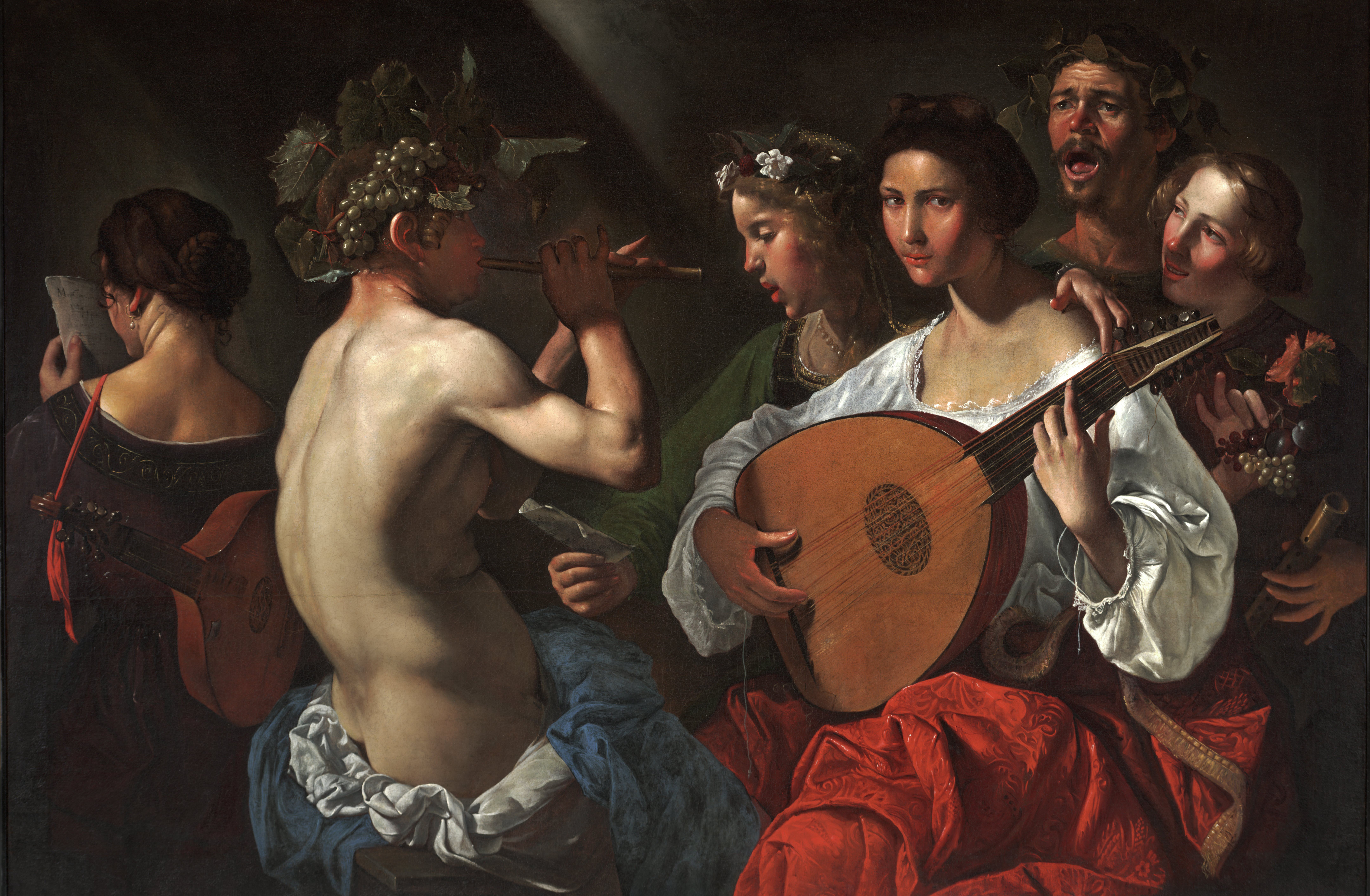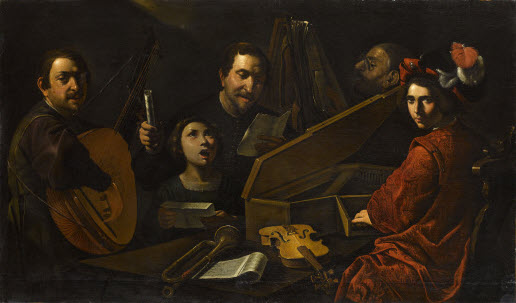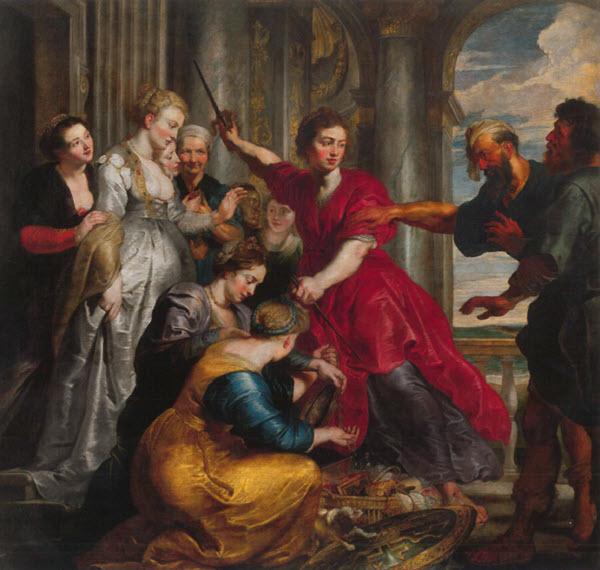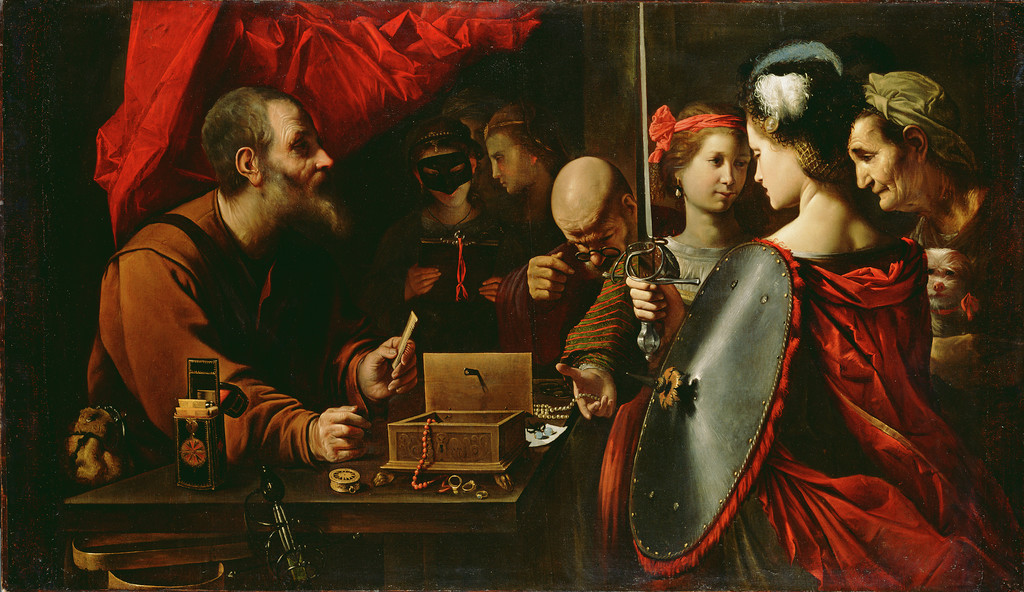With its dramatic lighting and figures cast in relief, Achilles Among the Daughters of Lycomedes demonstrates Pietro Paolini’s stylistic affinity for Caravaggio and his followers, to whom he was exposed early in his career. However, its unusual subject matter and staging suggest he also forged links between the painting’s mythological content, baroque theater, and early modern beliefs relating to gender, sex and identity. The painting depicts an episode described in the unfinished epic, The Achilleid, by the 1st century Roman poet Statius.1 In an attempt to prevent her son’s death in battle, Achilles’ mother Thetis entrusted him to King Lycomedes on the island of Skyros, where he assumed the identity of one of the King’s daughters. Ulysses, intent on enlisting Achilles to fight at Troy, presented gifts of jewels and other finery to the King’s household, together with a sword and shield. Here, Paolini portrays Achilles as a beautiful young woman in a flowing red dress, his back and shoulders illuminated. The painting shows the moment of discovery when Achilles grasps the weapons, revealing his true identity.
Born in Lucca in 1603 to one of the city’s old and esteemed families, Paolini left few contemporaneous records of his life and work.2 According to his early biographer, Filippo Baldinucci (1625–1696), he moved to Rome in 1619 to study classical and Renaissance masterpieces and developments in contemporary painting. He soon came under the influence of the Caravaggesque painter Angelo Caroselli (1585–1652) and joined the circle of Italian and Northern artists, such as Bartolomeo Manfredi, Valentin de Boulogne and Simon Vouet, who had adopted aspects of Caravaggio’s distinctive approach, producing gallery pictures for the Roman aristocracy and Papal Court.3 By the early 1630s, following the death of his parents, Paolini returned to Lucca for the rest of his long career, and around this time his paintings begin to show clear evidence of direct exposure to Venetian painting. His Martyrdom of Sant’Andrea (about 1637, Lucca, Chiesa di San Michele in Foro), for example, incorporates a classical backdrop and the warm, atmospheric colors of Veronese.4


The present painting evinces strong formal similarities to several of Paolini’s pictures that reflect the influence of Caravaggio’s tenebrist stylings, such as Bacchic Concert (about 1625–30, Dallas Museum of Art) (fig. 1) and Concert of Musicians and Singers (about 1625, Paris, Louvre Museum) (fig. 2). As in these compositions, Paolini presents a row of figures and objects in relief. Light illuminates faces, hands and the surface of objects, vividly capturing the episode’s climactic moment when Ulysses recognizes Achilles, and Achilles, eyes fixed on the sword, recognizes his own destiny. Anna Ottani, who first attributed the painting to Paolini, positioned it at an inflection point in Paolini’s career, noting the “plastico-luminous” tendencies of Caravaggio (the way light both defines and pools over faces), but also a more expansive approach to space characteristic of his later paintings.5 Indeed, Achilles’ dress billows up in the back, as if he is moving into the picture from outside the frame, and the rear wall gives way to an antechamber, where three additional figures seem both part of and separate from the scene unfolding in the foreground. The painting may date to Paolini’s sojourn in Rome or to the years that followed, when the influence of the Caravaggistis was still strong but he was experimenting with new formal idioms.6
The subject matter of the present painting was unusual in Italian painting in the early seventeenth century, and the visual or textual sources that Paolini may have referenced are undocumented. However, Paolini’s approach may have been shaped in literary and scholarly circles in Rome, Lucca and Venice. In one of the few documentary traces of Paolini’s time in Rome, the art collector and writer Giulio Mancini (1559–1630) stated that Paolini “veniva tirato dal diletto delle matematiche, musica e poesia” (“was drawn in delight to mathematics, music and poetry”) suggesting an ample intellectual and literary curiosity.7 He had a lifelong friendship with the noted Lucchese poetess Isabetta Coreglia (before 1605–?), who wrote nearly two dozen poems praising Paolini’s paintings. And both Paolini and Coreglia seem to have maintained a friendship with the writer Michelangelo Torcigliani (1618–1679), who, like Paolini, hailed from Lucca and studied in Rome, then went on to become a successful librettist in Venice.8 Given this network of associates, consideration of literature and theater in this period sheds light on Paolini’s iconographic choices, and how the painting would have been understood by contemporary viewers.
The story of Achilles on the island of Skyros was of increasing interest to audiences in the early seventeenth century. Not part of the original Homeric version of the legend, it was described in a number of ancient and early modern texts, including Statius, Philostratus the younger, and Natale Conti’s Mythologiae (first published in Venice in 1567).9 Statius offered the most detailed account, describing the arrival of Ulysses at the King’s court, the evening’s entertainment, and the ruse deployed to induce Achilles to shed his disguise, and new editions of The Achilleid, together with commentaries, were published in Antwerp (1595), Leyden (1616), and Paris (1601 and 1618).10 As the text became more available, the subject was also increasingly taken up by European painters. Among the most notable examples to predate Paolini’s picture was Achilles Discovered by Ulysses and Diomedes (1618/19, Madrid, Prado Museum) from the workshop of Peter Paul Rubens, painted mostly by his then-disciple Anthony van Dyck11 (fig. 3). The painting depicts a slightly later moment, one well-suited to Rubens’s energetic and fluid compositions, when Achilles leaps up with sword in hand and Ulysses grabs him by the arm. The painting infuses the moment with a mythic grandeur: Lycomedes’ palace is depicted as a classical portico, with ornate pilasters, columns and capitals, and Achilles’s heroic posture, arms raised, appears to be modeled on the famous Tazza Farnese.12

While Paolini’s formulation is radically different, there are echoes of Statius in his imagery, suggesting possible familiarity with the classical text: Achilles’ strong grip (his fingers are sharply defined and illuminated) evokes the moment when, his identity revealed, “his hands swallowed up the shield and the spear.”13 And the shield’s crimson trim recalls how Statius described it, shining red with “the fierce stains of war.”14 But the setting suggests not the mythic drama of Statius’s epic, but drama in the theatrical sense. Paolini’s figures occupy what appears to be a stage or set, with a simple wooden table and unadorned walls. Behind the principal figures, a red curtain is pulled back to reveal a trio of the King’s daughters, one of whom wears a mask of the type worn by performers. As Anna Ottani has suggested, the painting seems not to depict a mythological scene per se, but instead a “garbata commedia” (“gentle comedy”) performed in a small baroque theater.15
When Paolini produced the present painting, the story of Achilles on Skyros had emerged as a popular subject in theater and opera, and Achilles’s gender-bending disguise took center stage. In one of the earliest productions, Tirso de Molina’s play, El Aquiles (1612), based in part on Statius’s account, a female actress played the role of Achilles dressed in high heels for comedic effect.16 A Venetian opera based on the story, La Finta Pazza, (with a libretto by Giulio Strozzi) debuted at the Teatro Novissimo in 1641 to enormous acclaim (the first performance in the first theater specifically devoted to opera) and became one of the most popular operas of the seventeenth century, restaged in cities up and down the Italian peninsula. Audiences delighted less in Achilles’ heroicism than in his transvestitism, driven in part by very real anxieties about the biological and social components of sex. On stage, Achilles reveled in his gender fluidity: “Oh sweet change of nature,” he proclaimed, “a woman transforming herself into a man, a man changing himself into a woman . . . how many of you envy my state, that of being both man and girl.”17
The popularity of the story in theater and opera raises intriguing questions about Paolini’s painting, such as the notable inclusion of mirrors among Ulysses’s gifts. The first is attached to the inside of the comb case on the table, and the second, in the hands of the young woman behind the curtain, who seems to admire her own reflection. A young woman with a mirror typically symbolized vanity or truth, but here, the fact that she wears a mask – as both princess and performer – seems to implicitly question whether looks and identity can be believed. We might detect a third mirror, compositionally, in the rectilinear shape created by the blade and hilt of Achilles’ sword, which seems to frame the daughter whom he faces. Rather than acknowledge this mirror’s reflected image, Achilles averts his eyes to the weapon in his hand, the first clue to his imminent shift in gender.
The jewelry, gifts and clothes so prominently displayed in Paolini’s painting also played a role in contemporary anxieties about gender and identity. In addition to mirrors and combs, Paolini’s roster of gifts include rings and pearls, as well as a red ribbon that one of Lycomedes’ daughters has already tied in her hair. Among the heated debates about the distinction between men and women in seventeenth-century Italy was the notion that luxurious clothing and jewelry could destabilize sexual identity, that to don a woman’s dress was to become, in essence, a woman. In Venice, men who wore flamboyant clothing were compared explicitly – and often critically – to Achilles during his episode as a woman on Skyros.18 While much about Paolini’s process and patronage are unknown, the painting contains tantalizing visual clues about a richly layered investigation of the links between the real and the fictive, presentation and performance, and the classical and contemporary worlds. The complex iconography and staging in Achilles Among the Daughters of Lycomedes speak to his immersion in a sophisticated milieu, and one in which such themes found visual expression.
- David Bardeen
-
Ulysses’ discovery of Achilles among the daughters of Lycomedes appears in Statius, Achilleid, 1: 675-960. ↩︎
-
Praised as a “pittore di gran bizzaria, e di nobile invenzione” (“a painter of the bizarre, and of noble invention”) by the early art historian Filippo Baldinucci (1625–1696), Paolini rarely signed and dated his works, which presents challenges when studying his paintings. Accounts of his career were provided by two early biographers, Filippo Baldinucci (1625–1696) and Giacomo Sardini (1750–1811), whose notes on Paolini were published posthumously by Tommaso Trenta in 1822. Tommaso Trenta, Notizie di pittori, scultori e architetti lucchesi . . ., in Memorie e documenti per servire all’istoria del Ducato di Lucca, VIII, Lucca 1822, pp. 136-143. For the most comprehensive account of Paolini’s early training, professional associations, and stylistic development, see Patrizia Giusti Maccari, Pietro Paolini, pittore Lucchese (Lucca: Maria Pacini Fazzi editore, 1987). See also Anna Ottani, “Per un caravaggesco Toscana: Pietro Paolini (1603–1681),” Arte antica e moderna 21 (January/March 1963), pp. 19-35; Anna Ottani, “Integrazioni al catalogo del Paolini,” Arte antica e moderna 30 (April/June 1965), pp. 181-187. ↩︎
-
Caroselli was “caravaggesco di educazione” (“Caravaggesque by education”) according to L.A. Lanzi, Storia pittorica della Italia, I, Bassano, 1795–1796, p. 237. ↩︎
-
According to Tuscan painter Antonio Franchi (1638–1709), Paolini founded an “accademia del nudo” in 1652, and his instruction of a new generation of Lucchese painters has contributed to the challenge of distinguishing his corpus of works. For a recent overview of Paolini’s life and work, including a bibliography and documentary sources, see Elisabetta Giffi, “Pietro Paolini,” Dizionario Biografico degli italiani, vol. 81, 2014, http://www.treccani.it/enciclopedia/pietro-paolini_(Dizionario-Biografico) (accessed September 2, 2020). ↩︎
-
Ottani 1965 (note 2), p. 184. In her monograph on Paolini, Patrizia Giusti Maccari also characterized the painting as an effort to experiment with new stylistic and compositional possibilities. She noted the contrast between the melancholy atmosphere of the scene and the exuberant red folds of the curtain and Achilles’ garment, liking the latter to the stylings of Pietro Cortona. Giusti Maccari 1987 (note 2), p. 64. ↩︎
-
Elisabetta Giffi describes the painting as exhibiting an “impegno caravaggesco” (“Caravaggesque commitment”) but does not date it to his Roman years specifically. Giffi, “Pietro Paolini,” Dizionario biografico degli italiani 81 (2014), accessed September 1, 2020, http://www.treccani.it/enciclopedia/pietro-paolini\_(Dizionario-Biografico)/ ↩︎
-
Giulio Mancini, Considerazioni sulla pittura, ed. A Marucchi (Roma 1956), vol 1, p. 256. ↩︎
-
For Paolini’s relationship with Coreglia and Torcigliani, see Eva Struhal, “Pittura e Poesia a Lucca nel Seicento, il Caso di Pietro Paolini,” in Lucca cittá d’arte e i suoi archive; opera d’arte e testimonianze documentarie dal Medioevo al Novecento (2001), pp. 389-404. ↩︎
-
For the sources of the Achilles legend and its early modern publication history, see Richard B. K. McLanathan, “‘Achilles on Skyros’ by Nicolas Poussin,” Bulletin of the Museum of Fine Arts 45, no. 259 (Feb., 1947), pp. 4-11. ↩︎
-
For the early modern reception of Statius, including his other surviving epic, The Thebaid, see Valéry Berlincourt, “The Early Modern Thebaid,” in William J. Dominik, C.E. Newlands and K. Gervais, eds., Brill’s Companion to Statius (Leiden and Boston: Brill, 2015), pp. 543-561. ↩︎
-
See Alejandro Vergara, “Achilles Discovered by Ulysses and Diomedes,” in The Young Van Dyck, exh. cat. (Madrid: Museo Nacional del Prado, 2012), pp. 241-245. ↩︎
-
Vergara 2012 (note 11), p. 241. ↩︎
-
Statius, Achilleid, 1: 874-885. ↩︎
-
Statius, Achilleid, 1: 841-865. ↩︎
-
Ottani 1965 (note 2), p. 184. Paolini seems to have relished mixing the allegorical and mythological with the real and performative. It has been argued that his Bacchic Concert (fig. 1), with its strange band of musicians, including a young Bacchus, grapes in his hair and playing the pipes, depicts musicians in costume playing at an extravagant Roman wedding. Andrea Bayer, “Bacchic Concert,” in Keith Christiansen, ed. A Caravaggio Rediscovered: The Lute Player (New York: Metropolitan Museum of Art, 1990), cat. no. 14, pp., 72-73. See also Bonnie Pitman, ed. "Bacchic Concert," in Dallas Museum of Art: A Guide to the Collection (New Haven, CT: Yale University Press, 2012), p. 150. ↩︎
-
Anita K. Stoll, “Achilles: Gender Ambiguity and Destiny in Golden Age Drama,” in Frederick A. de Armas, ed., A Star-crossed Golden Age: Myth and the Spanish Comedia (Lewisburg: Bucknell University Press, 1998), pp. 114-116. ↩︎
-
"Dolce cambio di Natura, / Donna in huomo trasformarsi, / Huomo in donna tramutarsi, / Variar nome e figura / . . . . Quanti invidiano il mio stato, / Per far l’humo e la donzella?" As quoted in Ellen Rosand, Opera in Seventeenth Century Venice: The Creation of a Genre (University of California Press, 2007), p. 20. See also Peter J. Heslin, The Transvestite Achilles: Gender and Genre in Statius’ Acchilleid (Cambridge: Cambridge University Press, 2005), pp. 3-7. ↩︎
-
Wendy Heller, Emblems of Eloquence: Opera and Women’s Voices in Seventeenth-Century Venice (Berkeley: University of California Press, 2003), p. 70, fn. 109. ↩︎
